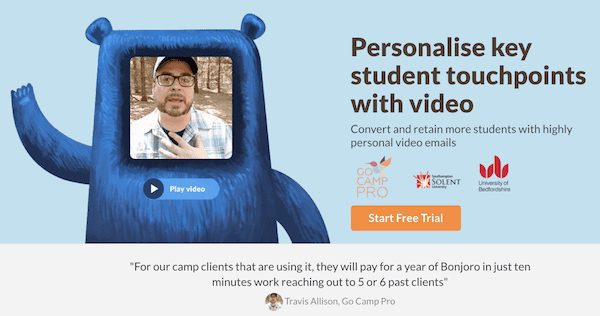

A lot has changed in the world of online courses since I founded Learning Revolution. As more people discover the value of lifelong learning, the marketplace for online courses has grown dramatically – and become much more crowded.
We’re rapidly headed toward a global e-learning market worth more than US $400 billion. More students are enrolling in courses every day — Teachable has over 15 million of them — but the number of available courses is also growing. Teachable creators have published more than 180,000 courses, and Udemy has more than 175,000.
That’s more than 350,000 courses hosted through just two sites!
Bottom line: if you want to be successful at selling online courses, standing out from the crowd is a skill you must master.
Slashing prices might seem an obvious way to attract learners, but I advise against it for a number of reasons. In fact, I suggest you do the opposite. Instead of joining everyone else on the race to the bottom, add value to your course and rise to the top. Here’s how to do it.
1. Add Context to Your Course
The value you offer rests on the benefit your customers gain from taking your course. What major positive outcome do they walk away with, what new knowledge have they gained, and how can they use it in their everyday lives?
Once you know your “added extra,” make sure potential learners know about it. Go beyond “I’ll teach you X” and put that learning into context by giving concrete examples of when and how the knowledge you’ll impart will make a difference. Testimonials from past customers and other forms of social proof are invaluable shortcuts in showing new learners what they stand to gain.
Use context in your classes as well. Tell stories as you teach and your lessons become ingrained in long-term memory, leading to better retention and better course outcomes for you.
2. Provide Optional Deep Dives
Engaged students are the lifeblood of an edupreneur’s business. They’re your best advocates and their feedback is invaluable in ensuring your online course’s continued success. Keep them happy by providing optional deep dives into key lessons. Including advanced materials, webinars, conference recordings, and papers will give keen students the chance to go above and beyond, and reinforce that they’re getting more from your classes than any other.
It’s true that only a subset of your students may take advantage of the options, but your other students will notice that you are continually delivering high value. And the students who do take advantage are likely to become vocal advocates for your offerings as well as great sources of ideas for new offerings.
3. Use Multiple Formats
While there is plenty of research debunking learning styles at this point (just do a search on “learning styles debunked”), it’s still true that we all learn best when exposed to information through a variety of different media. And, of course, leveraging a single piece of content to create multiple types of content just makes sense from the standpoint of increasing the perceived value of your offerings and generating content that you can use for marketing.
Turn video content into audio-only content, Get audio and video content transcribed using a service like Rev.com. Create infographics and charts using tools like Canva to to supplement your course materials. You get the picture.
Remember: everything is a production event.
4. Feature Guest Instructors
Showcasing industry experts is a key way to add value to your course, and a great promotional tool to drum up new customers. Involve a guest instructor who can join you on a podcast, chat with your students during office hours, or lead their own lesson. And don’t worry that bringing in an outside expert will diminish your standing with a student. Interacting with other experts can reinforce the perception that you are their peer and, in fact, help elevate your expertise.
Past students, or those on higher levels of a tiered course, also make good guests. They can help your students with the course materials or demonstrate real-world applications for the skills and knowledge they’re gaining. You can incentivize your advanced students to take part by offering course credits in return.
5. Don’t Be A Stranger
When selling any online course, the biggest source of value is you. It’s your knowledge and experience your customers want. Fostering mentor relationships with your students not only improves their learning outcomes; it positively affects their overall view of the course.
Provide multiple ways for your learners to contact you. Regular office hours, 1-on-1 consulting, and additional support all add value. Consider adding an extra time package to a course for students who want to spend an hour or two more with you each week or month to increase your income as well as make the standard course hours seem more generous.
All of this, of course, helps you not only to ensure your courses have real educational impact but also opens up new revenue options.
6. Create A Community
Group learning is a tried and tested method of teaching that can be difficult to achieve in an online setting. Creating an exclusive members’ group on Facebook, hosting messaging boards for course attendees on your website, or assigning study groups for certain modules all help foster a group identity within your customers.
With this one, be aware that you will need to put time into managing the community – posting fresh content, connecting people, encouraging people to contribute. I know from experience that it can take a while to get a community to “tip” to being self-sustaining. But keep at it, if you able to create a real community, it will be one of the most valuable assets you – and your learners – have.
See also: How to Build a Learning Community
7. Highlight Successes
Successful courses have high achieving students. Make it part of your routine to highlight when a student performs particularly well. Positive feedback reinforces their hard work, inspires more, and encourages the rest of your learners to take note and strive for special consideration themselves.
Providing group feedback when students perform well is also beneficial to learners who may be struggling to keep up. Seeing how a successful student approaches their work can help them understand their shortcomings, or even give you new ideas about how to approach and teach the course material.
And, be sure to follow to follow up with students over time to gather brief case studies on how they applied what you taught. (See “Stay in Touch” below.)
8. Leave No Learner Behind
Even more important than the successful students are those in danger of failing. Every learner enrolled on your course is a marketing success, and when they successfully complete the course and utilize their new learning, they can go on to provide valuable organic referrals for years to come.
When a learner fails to complete the course, that initial marketing success becomes a liability. You can mitigate this danger by identifying at-risk students as early as possible and offering them additional support and encouragement. A motivating phone call or email can work wonders, and there’s nothing more likely to make a student smile than receiving an old fashioned card through the mail.
Accepting small levels of failure is part of the edupreneur’s lot, but a student who feels you were always in their corner is less likely to blame the course (or you) for their inability to complete.
9. Make Completion Special
What do you offer the students who successfully complete your course? Plenty of online e-learning platforms offer template completion certificates, but this is another area where the personal touch really adds value to your online course.
You should, of course, offer a certificate, ideally with branding that is specific to you. But consider other ways you can acknowledge and celebrate each learner’s successful completion of your course. If you have a community, definitely post your congratulations in the community. And consider using an app like Bonjoro to deliver a personalized video message.


10. Stay In Touch
Remember the study groups I mentioned? Keep them open after your course has completed. Past students are a great source of leads for referrals, repeat enrollment, and testimonials or other social proof.
You can also choose to stay in touch with customers through the creation of alumni groups or hosted meet-ups. It’s down to you the extent of involvement you have with your students, particularly once they’ve finished a course, but they’re a significant resource for growing your brand and having a dynamic, engaged alumni group adds value by increasing your course’s desirability.
Bonus: Encourage Continued Learning
Keep your successful students coming back by offering discounts for repeat enrollers if you offer multiple or tiered courses. Even if you only have one course available, you can get your past students marketing on your behalf by offering affiliate incentives for every person they enroll on your course. (See my post on traits of great affiliate partners.)
Pick One and Act
You don’t have to do everything here at once, of course.
Figure out what makes the most sense for adding value to your particular course or courses and focus on implementing just one or two of these suggestions in the short term. You can always add in more over time as you start seeing results.
JTC
Image by U. Leone from Pixabay
Table of Contents


